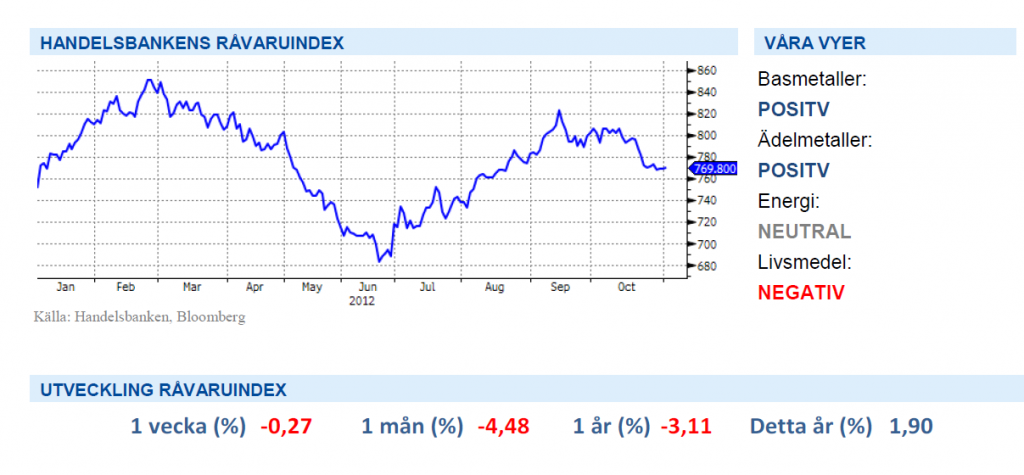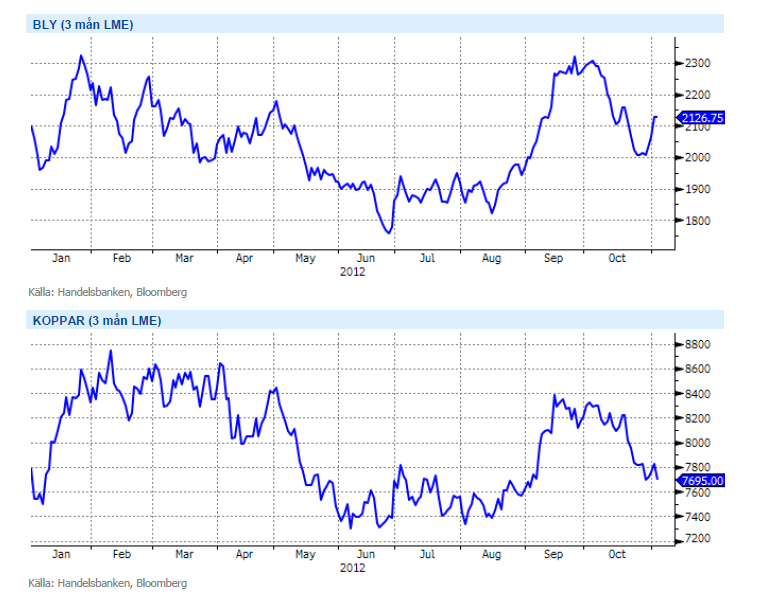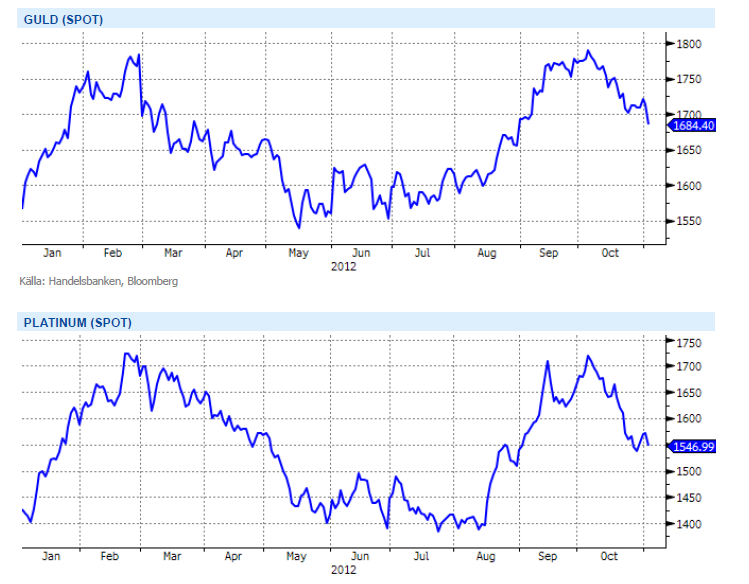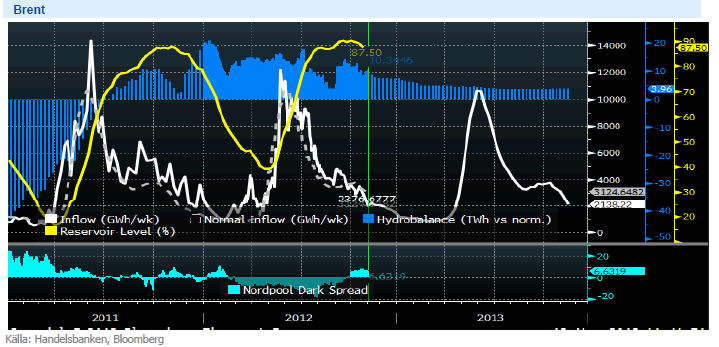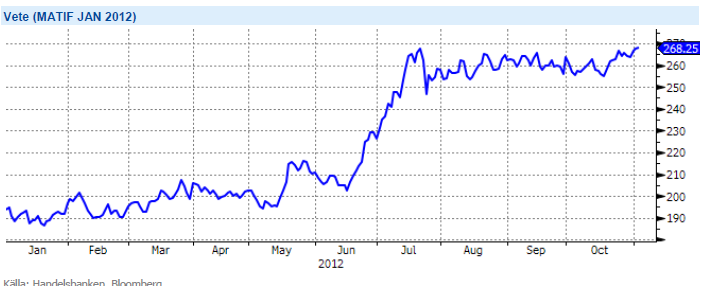Analys
SHB Råvarubrevet 2 november 2012
 Veckan bjöd på några gröna skott
Veckan bjöd på några gröna skott
Vi lämnar nu oktober och vi kan konstatera att månaden som gått bjöd på fallande priser på råvaror. Prisfallet på både metaller och energi ledde till att råvaror har haft det största fallet sedan maj under oktober månad med 4 %. Därmed ligger nedgången i paritet med börsen för samma period. Investerares optimism grusades av bland annat att IMF reviderade ner de globala utsikterna för tillväxt. Kina har rapporterat det sjunde kvartalet i rad med fallande tillväxt och inbromsningen i de 17 euroländerna fortsätter.
Bolagsrapporter har varit sämre än väntat och det har gjort att pessimism har spridit sig till råvarorna. Blickar vi framåt talar mycket för att Kinas ekonomi åter börjar få fotfäste och att botten på den kinesiska konjunkturen var under det tredje kvartalet. Veckan bjöd på några gröna skott i form av bra inköpschefsindex i USA och Kina. Den mest framåtblickande komponenten i inköpschefsindex, nya order, steg både i Kina och USA. Vi fortsätter därför att vara positiva till råvaror som tillgångsslag trots den motiga utvecklingen på marknaden under september. Antalet nya jobb i USA slog också förväntningarna idag och ger stöd åt USA:s återhämtning.
Basmetallerna
Är Kina på väg tillbaka?
Basmetallpriserna har under veckan utvecklats mestadels positivt. Alla metallerna har gått upp, med undantag för koppar som fallit cirka 1,3 % i pris. Zink och bly har visat på kraftiga uppgångar, upp respektive 2.2 % och 5,3 %. Under fredag eftermiddag föll basmetallerna på bred front på en förstärkt dollar.
Kopparpriset föll för den fjärde veckan i rad, främst till följd av höga lagernivåer i Shanghai. Uppgången i blypriset kunde förklaras med statistik som visade att produktionen hade fallit med 10 % i oktober, vilket var det största minskningen sedan i januari. Vi är fortsatt positiva till basmetallpriserna då vi ser tecken på att konjunkturen håller på att få upp farten i Kina och USA.
Buy on dips är intressant på basmetaller just nu. Under oktober har basmetallerna haft ett kraftigt ras, efter den kraftiga uppgången i september. Finansmarknaden hade handlat in för mycket på för kort tid. Däremot ser Kinadata allt bättre ut nu. Vi tror på: BASMET H
Ädelmetaller
Kalldusch för guldet efter jobbdata från USA
Positiva arbetsmarknadssiffror från USA och en stärkt dollar fick guldpriset att falla kraftigt under fredagseftermiddag. I skrivande stund handlas guldet på 1685 USD/uns – det är 1,85 % lägre än dagens öppning. Platinum har däremot stärkts under veckan från förra veckans nedgångar, men uppgången raderades under fredagen och platinum stänger veckan i oförändrad.
Arbetet vid guldgruvorna i Sydafrika är nu delvis återupptaget men utdragna rättsprocesser är att vänta. Gold Fields, världens fjärde största producent, uppskattar att strejkerna har kostat företaget uppåt 150 miljoner dollar.
Trots det senaste raset är vi fortsatt positiva till ädelmetaller där vi tror centralbanksstimulanserna är det största drivkraften.
Vi fortsätter att se centralbankernas nytryckta pengar och framförallt Feds QE3 operation som starkt skäl att vara investerad i ädelmetallerna. Konflikterna i Sydafrika fortsätter och ger stöd åt och guldpriset. Vi tror på: ADELMET H
Energi
Fortsatt svaga utsikter för elpriset
Oljepriset (Brent) har haft en fallande trend under veckan, efter positiva under fredag eftermiddag av positiva arbetsmarknadssiffror från USA steg priset 1,7 USD/fat men den uppgången raderades under eftermiddagen. Brent-oljan handlas nu på 107,70 USD/fat vilket är 1,2 % lägre än veckans öppning. Orkanen Sandy som svepte in över USA:s östkust tidigare i veckan har lämnat förstörelse och dödsfall efter sig. Orkanens framfart har även haft betydelse för oljepriset, främst priset på WTI-oljan som till motsats till Brent-oljan stigit under veckan. Mindre lager än väntat på råolja ger även det stöd till oljepriset. Amerikanska lager minskade med 2 miljoner fat mot en förväntad ökning på 1,8 miljoner fat.
Elmarknaden faller tillbaka närmare tre procent under veckan efter att såväl väder, spot, som tysk el verkat för lägre priser i Norden. Kol och utsläppsrätter handlas i stort sett oförändrat över veckan (89.50 dollar respektive 8 euro per ton) så inga större förändringar vad gäller brytpriset. Fokus är därmed återigen på vädret där temperaturen nu återgått till normala nivåer och ser ut att landa strax över normalt mot slutet av perioden. Energibalansen har förbättrats med närmare 2 TWh de senaste två veckorna (se blå graf nedan) och ser vi till prognoserna förväntas uppemot 7 TWh de kommande 10 dagarna vilket kan förbättra energibalansen med ytterligare någon TWh. Det är således svårt att motivera köp under rådande omständigheter, snarare sannolikt att marknaden faller tillbaka ytterligare 50 cent och testar 40 euro nivån för kvartalet Q1 2013 (underliggande för våra sparprodukter på el) om prognosen står fast över helgen. I övrigt noteras en stark tillväxt av vindkraft i kvartalsrapporten från Svensk vindenergi under 2012. 3,977 MW kommer att vara installerat i Sverige vid årsskiftet (ca 3% av Sveriges elanvändning) men pga av låga priser på el och elcertifikat förväntas endast 500 MW utbyggnad under 2013 (ca hälften av 2012 års installationer).
Oljan har sett allt svagare ut och vi fortsätter tycka att underliggande fundamenta är väl balanserad. Vi ser även att förutsättningarna för fortsatt lågt elpris kvarstår. Vi håller en neutral syn på energisektorn.
Livsmedel
Ökad oro för det amerikanska höstvetet
Terminspriser på vete har gått upp något sedan förra veckan i både Chicago och Paris. Det amerikanska höstvetet har längtat efter regn under en lång tid och skicket på grödan bedöms nu vara det värsta på 20 år vid den här tiden på året – vi har flera gånger sett att en dålig gröda lyckats återhämta sig väl efter vintern om vädret tillåter men helt klart har oron nu ökat. Det torra vädret har dock snabbat på sådden något, för vilken nu omkring 10 procent återstår. Något regn från stormen Sandy verkar inte ha nått de viktiga veteregionerna i USA i större utsträckning, vilket det talades mycket om i början av veckan.
Lite regn har fallit i Australien, möjligen kan det ha en positiv effekt på grödan längst ned i söder men generellt sett bedöms det vara för sent för att göra någon nytta. Fortsätter regnandet framöver lär det istället bli en nackdel då skörden i norr redan startat. I EU regnar det fortfarande i ganska stora delar och den del av sådden som kvarstår går sakta framåt, helt säkert kommer detta leda till en mindre höstsådd areal. I regndrabbade Argentina är skörden nu avklarad till omkring 6 procent, vädret har dock förbättrats något de sista dagarna men mer regn väntas under nästa vecka. I Östeuropa är det kallt och vetet börjar nu gå in i vintervila.
Väldigt mycket negativt är inprisat i dagens nivå och vi förväntar oss viss svårighet för priserna att nå så mycket högre. Långsiktigt är det svårt att se varför dagens nära rekordhöga priser ska hålla i sig – även om väldigt mycket kan hända till dess.
Vi ser soja, majs och vete som klara säljcase där vi väntar oss prisfall före jul men senast till påsk. Vi tror på: LIVSMEDEL S H
Handelsbankens Råvaruindex
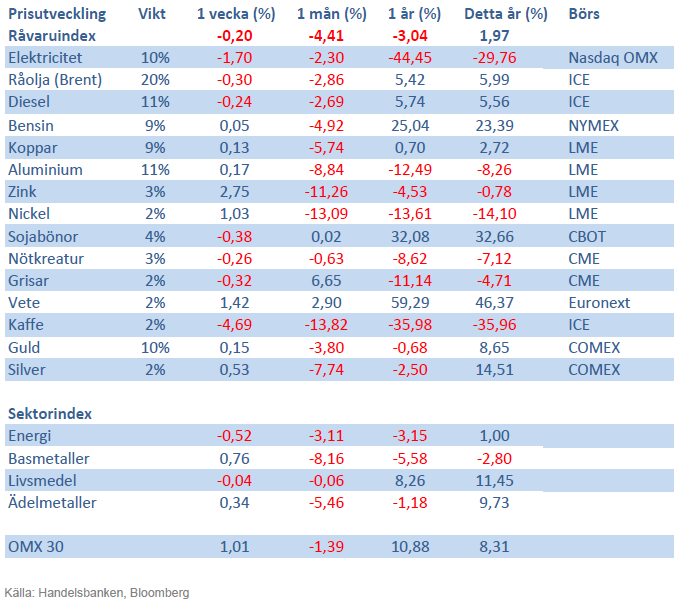
Handelsbankens råvaruindex består av de underliggande indexen för respektive råvara. Vikterna är bestämda till hälften från värdet av global produktion och till hälften från likviditeten i terminskontrakten.
[box]SHB Råvarubrevet är producerat av Handelsbanken och publiceras i samarbete och med tillstånd på Råvarumarknaden.se[/box]
Ansvarsbegränsning
Detta material är producerat av Svenska Handelsbanken AB (publ) i fortsättningen kallad Handelsbanken. De som arbetar med innehållet är inte analytiker och materialet är inte oberoende investeringsanalys. Innehållet är uteslutande avsett för kunder i Sverige. Syftet är att ge en allmän information till Handelsbankens kunder och utgör inte ett personligt investeringsråd eller en personlig rekommendation. Informationen ska inte ensamt utgöra underlag för investeringsbeslut. Kunder bör inhämta råd från sina rådgivare och basera sina investeringsbeslut utifrån egen erfarenhet.
Informationen i materialet kan ändras och också avvika från de åsikter som uttrycks i oberoende investeringsanalyser från Handelsbanken. Informationen grundar sig på allmänt tillgänglig information och är hämtad från källor som bedöms som tillförlitliga, men riktigheten kan inte garanteras och informationen kan vara ofullständig eller nedkortad. Ingen del av förslaget får reproduceras eller distribueras till någon annan person utan att Handelsbanken dessförinnan lämnat sitt skriftliga medgivande. Handelsbanken ansvarar inte för att materialet används på ett sätt som strider mot förbudet mot vidarebefordran eller offentliggörs i strid med bankens regler.
Analys
OPEC+ in a process of retaking market share

Oil prices are likely to fall for a fourth straight year as OPEC+ unwinds cuts and retakes market share. We expect Brent crude to average USD 55/b in Q4/25 before OPEC+ steps in to stabilise the market into 2026. Surplus, stock building, oil prices are under pressure with OPEC+ calling the shots as to how rough it wants to play it. We see natural gas prices following parity with oil (except for seasonality) until LNG surplus arrives in late 2026/early 2027.

Oil market: Q4/25 and 2026 will be all about how OPEC+ chooses to play it
OPEC+ is in a process of unwinding voluntary cuts by a sub-group of the members and taking back market share. But the process looks set to be different from 2014-16, as the group doesn’t look likely to blindly lift production to take back market share. The group has stated very explicitly that it can just as well cut production as increase it ahead. While the oil price is unlikely to drop as violently and lasting as in 2014-16, it will likely fall further before the group steps in with fresh cuts to stabilise the price. We expect Brent to fall to USD 55/b in Q4/25 before the group steps in with fresh cuts at the end of the year.

Natural gas market: Winter risk ahead, yet LNG balance to loosen from 2026
The global gas market entered 2025 in a fragile state of balance. European reliance on LNG remains high, with Russian pipeline flows limited to Turkey and Russian LNG constrained by sanctions. Planned NCS maintenance in late summer could trim exports by up to 1.3 TWh/day, pressuring EU storage ahead of winter. Meanwhile, NE Asia accounts for more than 50% of global LNG demand, with China alone nearing a 20% share (~80 mt in 2024). US shale gas production has likely peaked after reaching 104.8 bcf/d, even as LNG export capacity expands rapidly, tightening the US balance. Global supply additions are limited until late 2026, when major US, Qatari and Canadian projects are due to start up. Until then, we expect TTF to average EUR 38/MWh through 2025, before easing as the new supply wave likely arrives in late 2026 and then in 2027.
Analys
Manufacturing PMIs ticking higher lends support to both copper and oil

Price action contained withing USD 2/b last week. Likely muted today as well with US closed. The Brent November contract is the new front-month contract as of today. It traded in a range of USD 66.37-68.49/b and closed the week up a mere 0.4% at USD 67.48/b. US oil inventory data didn’t make much of an impact on the Brent price last week as it is totally normal for US crude stocks to decline 2.4 mb/d this time of year as data showed. This morning Brent is up a meager 0.5% to USD 67.8/b. It is US Labor day today with US markets closed. Today’s price action is likely going to be muted due to that.

Improving manufacturing readings. China’s manufacturing PMI for August came in at 49.4 versus 49.3 for July. A marginal improvement. The total PMI index ticked up to 50.5 from 50.2 with non-manufacturing also helping it higher. The HCOB Eurozone manufacturing PMI was a disastrous 45.1 last December, but has since then been on a one-way street upwards to its current 50.5 for August. The S&P US manufacturing index jumped to 53.3 in August which was the highest since 2022 (US ISM manufacturing tomorrow). India manufacturing PMI rose further and to 59.3 for August which is the highest since at least 2022.
Are we in for global manufacturing expansion? Would help to explain copper at 10k and resilient oil. JPMorgan global manufacturing index for August is due tomorrow. It was 49.7 in July and has been below the 50-line since February. Looking at the above it looks like a good chance for moving into positive territory for global manufacturing. A copper price of USD 9935/ton, sniffing at the 10k line could be a reflection of that. An oil price holding up fairly well at close to USD 68/b despite the fact that oil balances for Q4-25 and 2026 looks bloated could be another reflection that global manufacturing may be accelerating.
US manufacturing PMI by S&P rose to 53.3 in August. It was published on 21 August, so not at all newly released. But the US ISM manufacturing PMI is due tomorrow and has the potential to follow suite with a strong manufacturing reading.
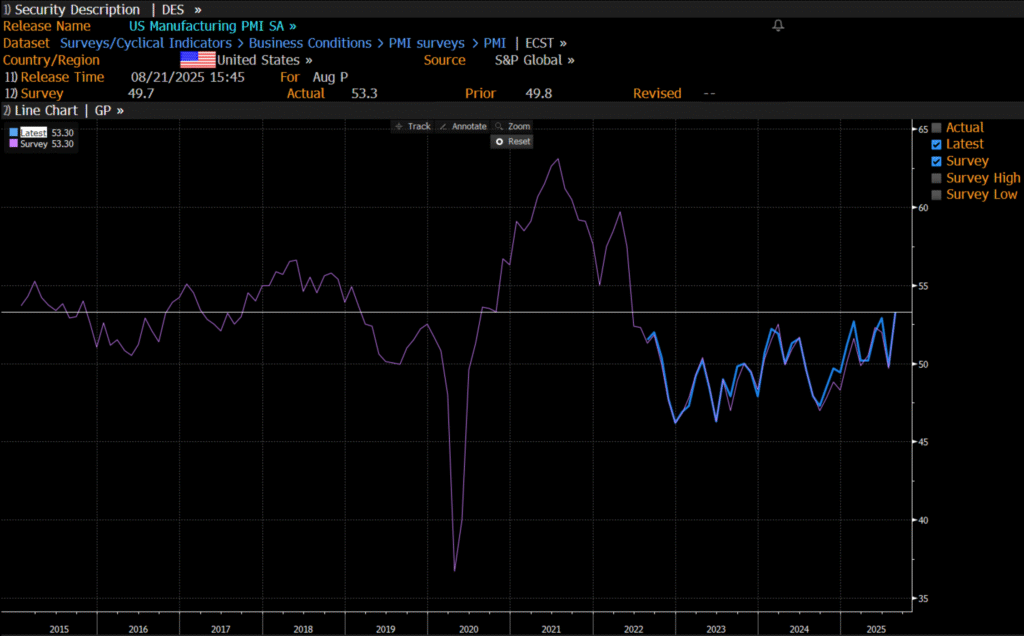
Analys
Crude stocks fall again – diesel tightness persists

U.S. commercial crude inventories posted another draw last week, falling by 2.4 million barrels to 418.3 million barrels, according to the latest DOE report. Inventories are now 6% below the five-year seasonal average, underlining a persistently tight supply picture as we move into the post-peak demand season.

While the draw was smaller than last week’s 6 million barrel decline, the trend remains consistent with seasonal patterns. Current inventories are still well below the 2015–2022 average of around 449 million barrels.
Gasoline inventories dropped by 1.2 million barrels and are now close to the five-year average. The breakdown showed a modest increase in finished gasoline offset by a decline in blending components – hinting at steady end-user demand.
Diesel inventories saw yet another sharp move, falling by 1.8 million barrels. Stocks are now 15% below the five-year average, pointing to sustained tightness in middle distillates. In fact, diesel remains the most undersupplied segment, with current inventory levels at the very low end of the historical range (see page 3 attached).
Total commercial petroleum inventories – including crude and products but excluding the SPR – fell by 4.4 million barrels on the week, bringing total inventories to approximately 1,259 million barrels. Despite rising refinery utilization at 94.6%, the broader inventory complex remains structurally tight.
On the demand side, the DOE’s ‘products supplied’ metric – a proxy for implied consumption – stayed strong. Total product demand averaged 21.2 million barrels per day over the last four weeks, up 2.5% YoY. Diesel and jet fuel were the standouts, up 7.7% and 1.7%, respectively, while gasoline demand softened slightly, down 1.1% YoY. The figures reflect a still-solid late-summer demand environment, particularly in industrial and freight-related sectors.


-

 Nyheter3 veckor sedan
Nyheter3 veckor sedanOmgående mångmiljardfiasko för Equinors satsning på Ørsted och vindkraft
-
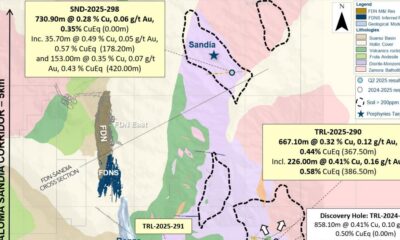
 Nyheter4 veckor sedan
Nyheter4 veckor sedanLundin Gold hittar ny koppar-guld-fyndighet vid Fruta del Norte-gruvan
-

 Nyheter2 veckor sedan
Nyheter2 veckor sedanMeta bygger ett AI-datacenter på 5 GW och 2,25 GW gaskraftverk
-

 Nyheter4 veckor sedan
Nyheter4 veckor sedanGuld stiger till över 3500 USD på osäkerhet i världen
-

 Analys3 veckor sedan
Analys3 veckor sedanWhat OPEC+ is doing, what it is saying and what we are hearing
-

 Nyheter4 veckor sedan
Nyheter4 veckor sedanAlkane Resources och Mandalay Resources har gått samman, aktör inom guld och antimon
-

 Nyheter2 veckor sedan
Nyheter2 veckor sedanAker BP gör ett av Norges största oljefynd på ett decennium, stärker resurserna i Yggdrasilområdet
-

 Nyheter4 veckor sedan
Nyheter4 veckor sedanLyten, tillverkare av litium-svavelbatterier, tar över Northvolts tillgångar i Sverige och Tyskland


